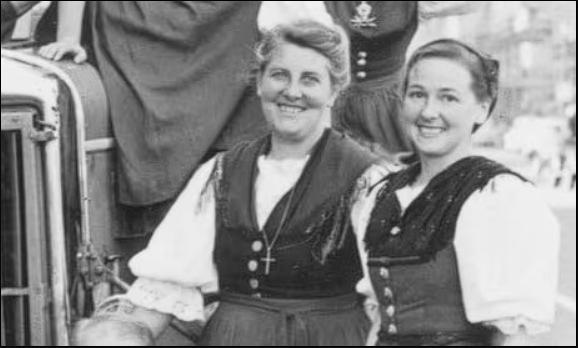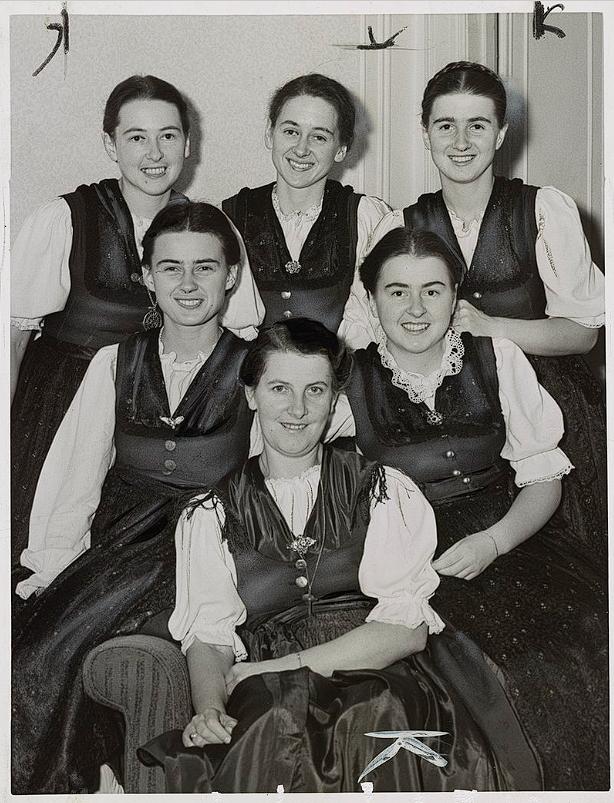The Real Liesl: Agathe von Trapp and the Truth Behind the Music
Long before The Sound of Music immortalized the von Trapp family, Agathe von Trapp lived the quiet strength of a girl destined to be more than just the fictional “Liesl.” Though she inspired one of musical cinema’s most beloved characters, Agathe’s real story—grounded in war, migration, and resilience—is far more compelling than the silver screen ever suggested.

Born in 1913, Agathe was the first daughter of Captain Georg von Trapp and his first wife, Agatha Whitehead. She grew up in a household filled with discipline, duty, and eventually, deep sorrow. When her mother died in 1922, Agathe was just nine—and from that moment on, she became both sister and surrogate mother to her younger siblings.
A Life Interrupted by Loss—and Transformed by Music
The arrival of Maria Kutschera in the mid-1920s changed everything. First hired as a tutor for Agathe’s ailing sister, Maria would soon marry Georg and bring not only a new kind of love but also a new presence of music and faith into the household.
Agathe was initially resistant to Maria. She was a teenager navigating loss and change. But over time, the bond between the children and their new stepmother solidified—especially through music. Agathe, with her clear soprano voice and natural stage presence, became a central figure in the Trapp Family Singers.
She sang first soprano, played guitar, and helped arrange performances. More than just a performer, Agathe was a creative heart within the ensemble, often crafting costumes and organizing musical elements alongside her siblings.
Escape from Austria and Building a New Life
As the shadow of Nazism crept over Austria in 1938, the von Trapps made the courageous decision to flee. Captain von Trapp’s refusal to cooperate with Hitler’s regime meant that staying would be dangerous. Disguised as a concert tour, their departure marked the beginning of a long and uncertain journey.
In America, Agathe had to reinvent herself once again. The family sang in churches and halls to support themselves. Gone were the comforts of Austrian nobility. Now, Agathe stitched clothes, washed dishes, and learned how to survive on foreign soil—all while bringing joy to others through music.
Beyond the Spotlight: Agathe’s Quiet Legacy
In 1956, after two decades of touring, Agathe chose a quieter life. She moved to Maryland, where she taught music and art to children. She never married, instead devoting herself to education, creativity, and service.
In her later years, Agathe finally told her own version of the story that had been fictionalized so often. In her memoir, Memories Before and After The Sound of Music (2003), she shared her memories—correcting myths, clarifying relationships, and offering a deeply personal portrait of life before, during, and after their flight from Austria.
She emphasized that the real von Trapp family was not as sugar-sweet as portrayed on screen. There was struggle, discipline, and moments of tension—but there was also deep love, unwavering faith, and extraordinary resilience.
Remembering Agathe von Trapp
Agathe passed away in 2010, at the age of 97. While the world remembers Liesl singing “I am sixteen, going on seventeen,” the true Agathe von Trapp left behind a far richer legacy—of art, independence, and quiet bravery.
She was not just the girl who inspired a musical. She was a woman who lived through the rise and fall of empires, crossed continents with only her voice to guide her, and remained faithful to her family, her music, and her truth.
